There are a variety of acronyms in the business world to maintain straight. search engine optimization, CRM, SERP, CDN, and CMS are just some essential ones.
CMS is especially essential, contemplating that more than 68 million websites are constructed with one. So what’s it?
CMS stands for content material administration system. It additionally often is the answer you are in search of to shortly make a website with restricted technical data and assets.
On this publish, we’ll outline what a CMS is and the way it works. Then we’ll have a look at how you should use a CMS to deal with the infrastructure of your web site so you may give attention to creating thrilling, pleasant content material that leads to extra conversions and leads.
We’ll wrap up by a few of the hottest CMS platforms available on the market. Let’s get began.
What’s a content material administration system (CMS)?
A CMS, quick for content material administration system, is a software program utility that permits customers to construct and handle a web site with out having to code it from scratch, or know find out how to code in any respect.
With a CMS, you may create, handle, modify, and publish content material in a user-friendly interface. You’ll be able to customise the design and performance of your web site by downloading or buying templates and extensions, reasonably than coding. You’ll be able to have a number of customers working within the back-end of the identical software — and rather more.
You may be questioning how one piece of software program does all of this. To reply that query, let’s take a better have a look at how a CMS works.
How a CMS Works
To grasp how a CMS works, you first have to know what it is wish to construct a web site from scratch.
You’d begin with HTML so as to add textual content, photographs, navigation bars, and different constructing blocks of a web site. You then’d add CSS to model these components to match the distinctive feel and appear of your model.
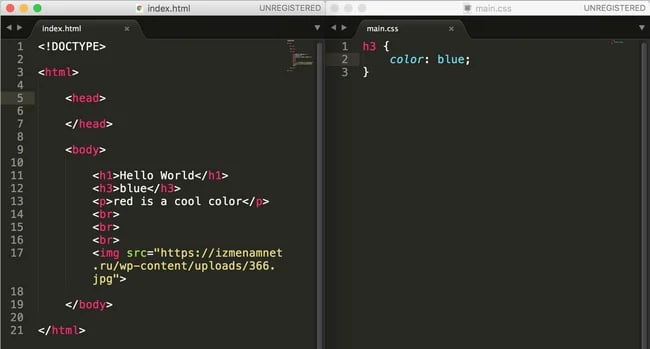
You’d end up by writing some JavaScript so as to add extra superior performance to your web site, like slide-in CTAs. You then’d need to add this HTML file to your server to be filed away in your database.
Everytime you need to make adjustments — even easy ones like updating content material — it’s important to obtain information from the server, open them, and alter the HTML code by hand. You then’ll need to be sure you did not break any hyperlinks or one thing else earlier than importing the information again to the server.
Sounds sophisticated, sure? For builders and different superior customers with expertise in website development, constructing a web site from scratch may be ideally suited. However for individuals who do not have the coding skills or time and assets to construct a web site from scratch and keep it, they’ll use a CMS. Let’s discuss how.
Learn how to Use a CMS
A CMS is made up of two core components: a content material administration utility (CMA) and content material supply utility (CDA). Mixed, these purposes primarily deal with all of the code, database queries, and infrastructure within the again finish so you may give attention to the entrance finish of your web site.
Slightly than begin with a clean HTML web page, for instance, you will open up the content material editor and give you the chance daring textual content, add hyperlinks and CTAs, and insert photographs and tables by dragging and dropping some modules or clicking a couple of buttons reasonably than writing out HTML, CSS, and JavaScript.
Here is a have a look at how simple it’s to create a blog post utilizing WordPress, for instance.
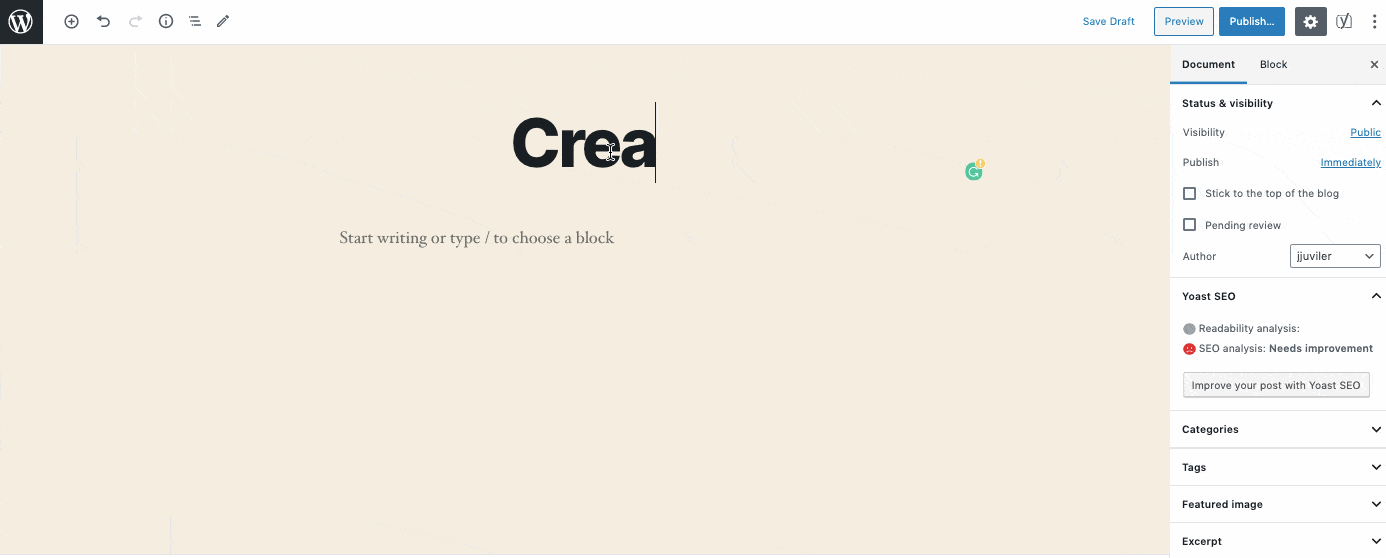
To make different adjustments in your web site, like altering the permalink construction or putting in extensions, simply navigate to the suitable part in your admin panel. That is the CMA in motion: all these adjustments are made in an intuitive interface that hides the code from you, the tip person.
Whenever you’re executed making adjustments, the CDA will take the content material you entered into the CMA, assemble the code, show it to your front-end guests, and retailer it. Meaning once you need to publish a brand new weblog publish, for instance, you simply need to hit the Publish button as an alternative of manually importing a web page to your server.
Now that we perceive what a CMS is, the way it works, and find out how to use it, let’s discover the advantages of utilizing one over constructing a web site from scratch or utilizing one other web site constructing software.
Why Use a CMS?
We have already alluded to some advantages of utilizing a CMS, however let’s take a look at some particular methods it might probably affect your set-up course of, crew’s productiveness, and visibility on-line.
1. No Coding Data Required
By enabling non-developers and different customers to construct web sites with out coding, CMS techniques have helped revolutionize internet design. Gone are the times of counting on internet builders and designers to ascertain an internet presence for your corporation.
You’ll be able to create and handle content material, customise the design of your web site, and set up extensions so as to add performance to your web site — all with out coding. (It is essential to notice that almost all platforms do can help you add customized code for extra granular management over your web site, too.)
Because of this, customers with restricted technical assets and time can nonetheless construct a strong web site for his or her enterprise.
2. Simple Collaboration
A number of customers can entry and work within the again finish of a CMS on the identical time. Meaning on any given day, your entrepreneurs will be producing content material, your IT professionals implementing safety protocols, and your builders including customized code to your theme. In reality, they may all be engaged on the identical touchdown web page.
HubSpot additionally provides a free CMS tool, which is ideal for entrepreneurs in search of a CMS that may develop with them as they scale their companies.
Briefly, a CMS may help enhance workflows and productiveness throughout your crew.
3. Person Roles and Permissions
A CMS lets you collaborate in essentially the most environment friendly and secure means doable because of built-in (and sometimes customizable) person roles and permissions. Meaning content material writers, for instance, can have all of the permissions they should write, publish, and handle content material — however will not be capable to delete plugins or in any other case considerably alter the positioning’s performance.
Here is a have a look at the Person Function Editor in WordPress.
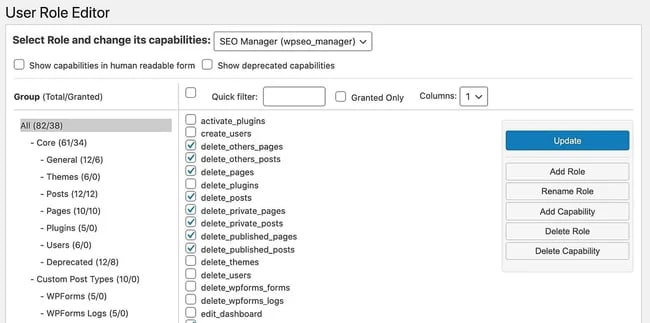
And not using a CMS, you’d need to code some fairly sophisticated situations and checks to create user roles and permissions in JavaScript.
4. search engine optimization Options and Extensions
CMS platforms supply built-in features in addition to add-ons that will help you optimize your web site for search engines like google and yahoo.
Utilizing built-in or third occasion instruments, you may:
Implementing these finest practices will assist enhance your probabilities of rating on Google and different main search engines like google and yahoo.
5. Safety Options and Extensions
CMS platforms additionally supply built-in options and add-ons that will help you safe your web site. Some even supply a devoted safety crew. Content Hub, for instance, supplies an enterprise-class web application firewall, SSL, custom CDN, SSO memberships, and and different out-of-the-box features.
6. Predesigned Templates
Most CMS platforms include a number of predesigned templates you should use to shortly customise the looks of your web site. They will additionally have an effect on the conduct of your web site.
Selecting a responsive template, for instance, will guarantee your web site seems good on any system, with out requiring you to write a bunch of code. Not solely do templates prevent design time earlier than launching your web site, they’ll additionally make a website redesign a lot sooner and less complicated down the highway.
Webflow is only one CMS that provides lots of of responsive templates.
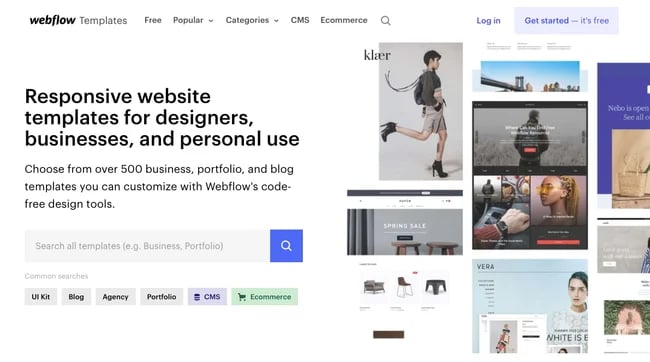
7. Easy Updates
As mentioned above, a CMS allows you to make adjustments in your web site sooner and simpler — from main updates, like a web site redesign, to minor updates, like altering the picture on your private home web page. Slightly than hiring a freelance developer or attempting to edit the code your self, you may go into the dashboard of your CMS to replace and edit the content material of your web site. This lets you maintain your content material dynamic and related.
8. Running a blog Performance
Blogging offers a range of benefits, significantly to companies. It could assist drive visitors to your web site, convert visitors into leads, set up authority in a specific business, generate backlinks, and obtain different long-term outcomes. However constructing a weblog from scratch is tough, even for skilled builders.
A serious benefit of utilizing a CMS is that almost all present built-in running a blog performance (or extensions) so it is easy to begin creating and publishing weblog content material and reaping the advantages.
9. Content material Scheduling
Scheduling content material is important to any editorial technique. When constructing a web site from scratch, you may schedule content material — however it should require a mix of coding and instruments like GitHub.
With a CMS, scheduling content material is as simple as clicking a button. Most platforms can help you schedule extra than simply weblog posts, too. With Content material Hub for instance, you may schedule weblog posts in addition to web site pages, touchdown pages, and emails.
Here is a have a look at the scheduling tab inside HubSpot’s weblog editor.
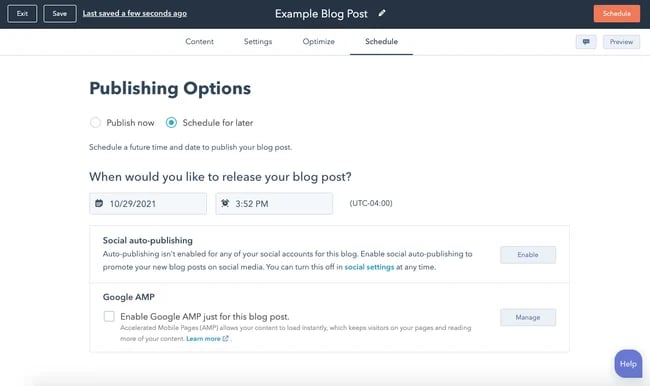
10. Simple Entry
With a CMS platform, you may entry and edit your web site on nearly any system with an web connection. That is a lot simpler than the choice of constructing a web site from scratch, which requires you to be on a tool linked to the server or join remotely.
Plus, most CMS techniques have a single dashboard or management panel the place you may entry your web site’s content material, theme, plugins, settings, and extra — multi function place.
In case your web site is rising, you might have to improve to a CMS to satisfy your wants. You can begin your search by trying out a couple of of the best CMS systems under.
CMS Platform Examples
- Content material Hub
- WordPress
- Joomla
- Drupal
- Magento
- Webflow
- Ghost
- Sitecore
Let’s unpack eight in style CMS platform examples to find which may be one of the best match on your web site wants.
1. Content Hub
Very best for: Any-sized companies
Value: $25 – $1,500 per 30 days
Why Use Content material Hub: With Content Hub, you may construct web sites which are safe, highly effective, and optimized for search engines like google and yahoo.
Utilizing this all-on-one linked platform, you may create customized content material for guests based mostly on knowledge out of your HubSpot CRM, create customized templates and types, run A/B checks on multi-language content material, safely redesign and relaunch internet pages, view efficiency analytics, and rather more.
By combining ease of use and suppleness, this proprietary CMS is right for companies with various groups of entrepreneurs, builders, and IT professionals that want to develop over time.
Learn more about Content Hub’s customization options, multi-lingual support, reporting dashboards, and more.

2. WordPress
Very best for: Small companies and freelancers
Value: Estimated between $30 to $3,000
Why Use WordPress: WordPress is a self-hosted platform that powers tens of millions of web sites. You’ll be able to simply and shortly construct a WordPress site utilizing the Gutenberg editor after which customise it with any of the 1000’s of plugins and themes accessible within the official WordPress listing or different third-party websites.
Need to add forms and live chat to your site? Need a theme that comes with a built-in visual builder and split testing? Leveraging WordPress plugins and themes like these, you may create a novel expertise particular to your model.
3. Joomla
Ideal for: Global companies
Price: Estimated between $700 to $6,500
Why Use Joomla: Web site house owners in search of extra performance constructed proper into the platform might strive a WordPress alternative like Joomla.
Like WordPress, Joomla is an open-source CMS. What units Joomla aside is its built-in multilingual assist and superior person and content material administration choices, which make it ideally suited for membership, neighborhood, and social networking websites. UIDAI, for instance, is a multilingual web site powered by Joomla.
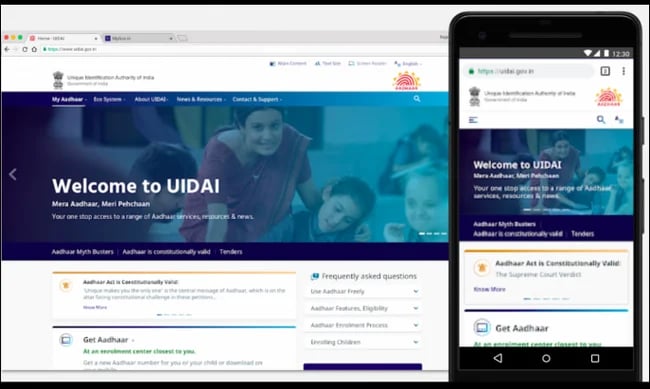
4. Drupal
Very best for: Corporatations and authorities companies
Value: Estimated between $5,000 to $20,000
Why Use Drupal: Drupal is a extremely versatile CMS favored by massive firms and authorities companies like NASA. Whereas you have to web development experience to totally leverage the facility of this platform, you will not have to begin from scratch.
Along with its out-of-the-box options, you may select amongst 47,000 modules accessible in its listing and 1000’s of free themes in its theme repository to construct a posh web site that handles massive volumes of knowledge and heavy visitors, like Rush College Medical Heart’s web site.

5. Magento
Very best for: Ecommerce companies
Value: Estimated at $15,000 and up
Why Use Magento: The self-hosted model of Magento, generally known as Magento OpenSource, is just like the Drupal of the ecommerce world. It is extremely versatile and safe, however tough to study and benefit from all its built-in performance and extensions.
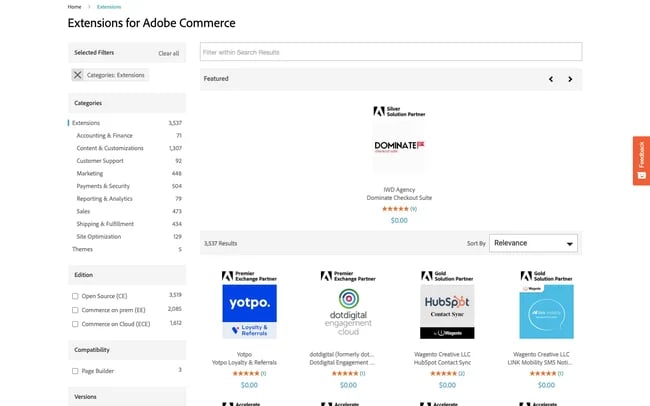
With Magento, you may handle a number of shops, use a number of worldwide delivery suppliers, and transact in numerous international locations, languages, and currencies — all inside the identical dashboard.
So, if in case you have the time and assets to put money into set-up and upkeep, you can construct an internet retailer with an enormous product stock and international attain.
6. Webflow
Very best for: Net designers and companies
Value: $15 – $235 per 30 days
Why Use Webflow: Webflow is a “visible” content material administration system designed to fill a market hole for internet designers who need to give attention to creating and customizing websites with out worrying about internet hosting, safety, or efficiency.
With Webflow, you can begin with one of many lots of of pre-built templates or begin from scratch utilizing the Webflow Designer proven under.

You can even lengthen the performance of your web site by way of third-party integrations or embedding HTML code. Because it requires no less than some data of HTML, CSS, and internet design, Webflow is finest fitted to freelancer designers or companies.
7. Ghost
Very best for: Bloggers
Value: $9 – $2,400 per 30 days
Why Use Ghost: Should you’re in search of a extra easy and light-weight CMS devoted to running a blog, Ghost is a good choice. Ghost is a headless CMS, which signifies that its physique (the content material repository) is separated from its head (the presentation layer).
Mainly, this lets you create and handle content material after which ship that content material through their Node.js APIs (or one other front-end software you favor) to any platform and channel, from smartwatches to virtuality actuality headsets.
With an intuitive editor and built-in search engine optimization instruments, Ghost appeals to bloggers and freshmen who need a fundamental web site that’s easy to create and handle.
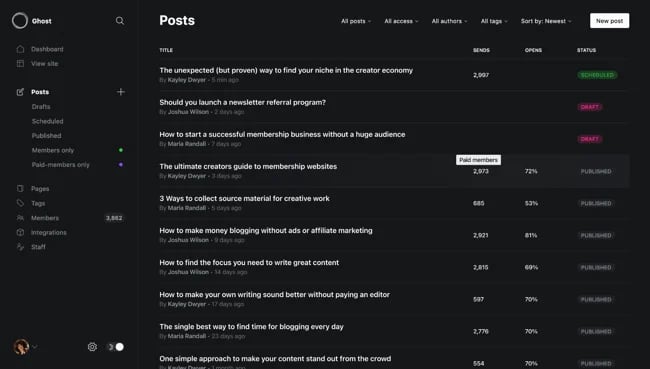
8. Sitecore
Very best for: Enterprise firms
Value: Must contact company for pricing info
Why Use Sitecore: Sitecore is an enterprise-level headless CMS that allows you to create and ship customized web sites, emails, social media posts, and cellular experiences.
You should utilize its WYSIWYG editor with drag-and-drop performance, session- and device-based personalization guidelines, and multilingual instruments to scale your content material creation and ship content material that’s optimized to your customers’ pursuits, language, and system. And because of Sitecore’s headless structure, you may present these related buyer experiences throughout a number of channels, together with internet, social, voice, level of sale, and extra.
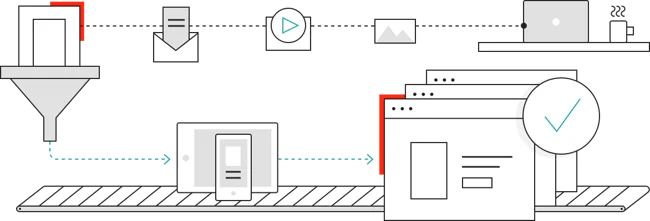
This CMS powers more than 120,000 websites in industries starting from sports activities to banking to journey and extra. A few of its greatest manufacturers are American Specific, ASOS, L’Oréal, and Volvo Automobiles.
Use a CMS to Construct Your Web site
Utilizing a content material administration system to construct and handle your web site may help you develop over time. Not solely will a CMS retailer your entire internet content material in a single place, it should additionally assist collaboration throughout groups, permit for fast and simple updates, and supply templates and extensions to customise your web site.
Editor’s be aware: This publish was initially printed in December 2010 and has been up to date for comprehensiveness.



